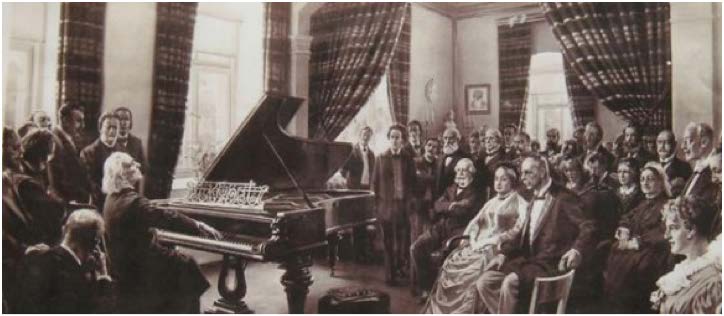Lately I’ve had some lovely opportunities to sit by history. At least that’s what I like to call it. While nothing tops walking into famous sites, there’s something magical about sitting next to them, particularly if circumstances allow one’s imagination to travel back in time.
Case in point: earlier this week I offered to mind two little children so that the adults could attend a noon-hour concert here in Weimar at a site known as Liszt’s Garden House. Inside a simple, square house that served as the Court’s garden house (Hofgärtnerei), the world-renown pianist and composer Franz Liszt changed the way music would be taught.
Across a string of years starting in 1869, Liszt spent his summers in this house, resting, composing, and inventing what we call “the master class”—a method of teaching groups by addressing intense instruction to a single member. Today, the master class is considered an efficient and effective way to teach. In fact, if you search the name of any famous artist today, you are likely to find fascinating videos of his or her master classes on line. But in Liszt’s day, this method of teaching was a daring idea.
Summers in Weimar were pleasant for Liszt—far pleasanter than his earlier years of court service (1849-1861) when he ultimately was booted out of town for his innovative compositions and overly demanding techniques of conducting. But most of that was forgotten in the later years of his towering fame. Weimar was lucky to get him back.
Liszt enjoyed the contrast these summer months afforded with his winter residencies: Budapest and Rome. At the edge of the massive Park on the Ilm, Liszt lived simply in the house, a narrow bed for his rest, a small dining room for entertaining, and a long salon holding his two pianos and study.

Into this salon he would invite students in the afternoons. Seated at his upright piano, his massive grand stretched out to his left, he would teach the secrets of his extraordinary pianism to his devotees. The pupils came from all over, including the United States (see the fascinating accounts penned by American pianist Amy Fay in her memoir Music Study in Germany).
Sometimes, in good weather, Liszt moved the musical discussion outside to what we would call the terrace before the modest front door. And that’s where I sat on Tuesday, watching my little charges scratch pictures in the dirt and chase glistening white butterflies who had gathered in extra abundance to hear the music.

Meanwhile, inside, selected students from Professor Grigory Gruzman’s studio at Weimar’s Liszt Musikhochschule (Liszt Conservatory) regaled their fortunate audience with masterworks by Liszt, Busoni, Chopin, Schumann, and Grieg.
How extraordinary it would be as a student to play Liszt’s pianos, framed by luxuriant red-and-green draperies recalling Hungary’s national colors, breathing the verdure of the park’s majestic trees outside the windows, setting the planks of flooring squeaking under the force of the pedals.
Nothing could compete . . . unless it was the pleasure I enjoyed sitting outside, contentedly, quelling the occasional squeals of the children, suspended between the realities of modern life and the sound of an aural past pouring out the windows.
And I learned that, as magical as it is to be in Liszt’s salon during a recital, it is just as magical to sit by, soaking up music from the sunlight garden. German weather is notoriously capricious, but the sun was remarkably constant, broken only by a raft of dark clouds that coincided with the most passionate sections of Liszt’s Dante Sonata. Rolando Valdes Pinal, a young Mexican pianist who thundered through that daunting piece, emerged a few moments after its crashing conclusion, exhausted, mostly happy, holding a long-stemmed red rose as he headed back to something far more mundane.
Liszt’s master-class pupils would have peeled out of the salon in the same way, their moments of glory cut short by the realities of life. Maybe they headed off to a supper of sausage and bread (occasionally Liszt joined them). Or maybe, discouraged at how the master class had gone, they stormed back to their rented flats for more practice. Or perhaps they simply took a walk through the park to absorb what they’d learned at the feet of the master.
That is, and always was, the life of a musician. It is the same today. These traditions we touch, see, and hear, are ongoing. And they shape our lives, whether we enter actively into them, or sit quietly next to them, absorbing their power.



